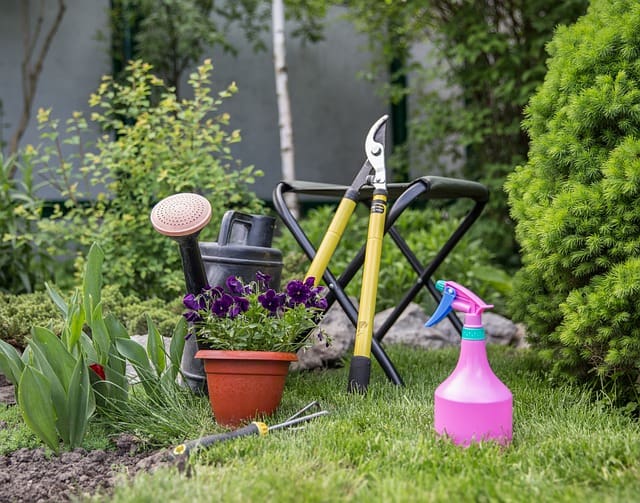As the saying goes, a flower does not think of competing with the flower next to it, it just blooms. However, as a gardener, it is natural to want your flowers to be the most vibrant and healthy in the neighborhood. With so many factors that can affect their growth, from weather conditions to soil quality, it can be overwhelming to know where to start. That’s where we come in.
In this guide, we will provide you with tips and tricks to help your garden flowers flourish and bloom beautifully. Whether you are a beginner gardener or have been gardening for years, there is always room for improvement when it comes to caring for your flowers. Let’s get to the list.
Get the Right Garden Structures
Having the right garden structures can make a huge difference in the health and growth of your flowers. These structures such as trellis, stakes, and supports can provide support for your flowers as they grow.
For tall or climbing plants, using a trellis can help them reach their full potential without risking damage to the stems. You can about what is a trellis and how to choose the right one for your garden. Stakes are also useful for keeping plants upright and preventing them from bending or breaking due to strong winds. Investing in these structures can not only protect your flowers but also enhance the overall appearance of your garden.
Keeping the structures well-maintained will also prevent any accidents or damage to your flowers. With the right garden structures, your flowers can reach their full potential and bloom beautifully in your garden.
Choose the Right Location for Your Flowers
The location of your flowers plays a crucial role in their growth and development. Choosing the right spot for each type of flower is essential as different plants have varying sunlight, soil, and moisture requirements. Some thrive in full sun while others prefer partial shade. It’s important to research each type of flower you want to grow and find out its specific needs.
Additionally, consider the microclimate of your garden – areas that are more sheltered or receive more wind can also affect plant growth. By carefully selecting the location for your flowers, you can give them the best chance to thrive and flourish in your garden.
Prepare the Soil Properly
The health of your flowers starts with the soil they are planted in. Before planting, it’s important to prepare the soil properly by removing any debris, weeds, and rocks. This will allow for better air circulation and drainage, which are essential for root growth.
Next, test the pH level of your soil to ensure it is suitable for the types of flowers you want to grow. Certain flowers thrive in acidic soil while others prefer alkaline or neutral soil. You can amend the pH level by adding organic matter or fertilizers accordingly. Good soil preparation will provide a strong foundation for your flowers to grow and thrive in.
Water Regularly and Properly
Water is essential for the growth of plants, but it’s important to water your garden flowers properly. Overwatering can lead to root rot and other issues, while underwatering can cause wilting and stunted growth.
The key is to water consistently and evenly, making sure the soil is moist but not soggy. It’s also important to water at the base of the plant rather than on the leaves, as this can lead to diseases and pests. Consider using a watering schedule or installing a drip irrigation system to ensure your flowers are getting the right amount of water at the right time.
Provide Adequate Sunlight
As mentioned earlier, different flowers have varying sunlight requirements. Some need full sun, while others prefer partial or even full shade. It’s important to know which plants need what type of light and to provide them with the appropriate amount.
If you have a garden with areas that receive varying amounts of sunlight, make sure to choose flowers that will thrive in those conditions. You can also strategically place taller plants or structures to provide shade for more delicate flowers. Keeping your flowers well-cared for and receiving the proper amount of sunlight will result in healthy and colorful blooms.
Protect Against Pests and Diseases


Pests and diseases are a common threat to garden flowers, but there are ways to protect your plants from them. One method is using natural repellents like neem oil or garlic spray. These can deter pests while also being safe for your flowers and the environment.
Another way to prevent pest infestations is by regularly inspecting your plants for any signs of damage or pests and taking action immediately. This can include removing affected leaves or using organic insecticides.
Proper care and maintenance, such as removing dead or diseased plant material, can also prevent the spread of diseases. By being proactive in protecting your flowers from pests and diseases, you can ensure their continued health and blooming beauty.
Ensuring your garden flowers thrive requires proper planning, preparation, and care. By following these tips and incorporating them into your gardening routine, you can provide the best environment for your flowers to flourish in. Remember to choose the right structures and location for your plants, properly prepare the soil, water them correctly, provide adequate sunlight, and protect against pests and diseases. Your flowers will thank you by blooming vibrantly and adding beauty to your garden.









Leave a Reply
View Comments